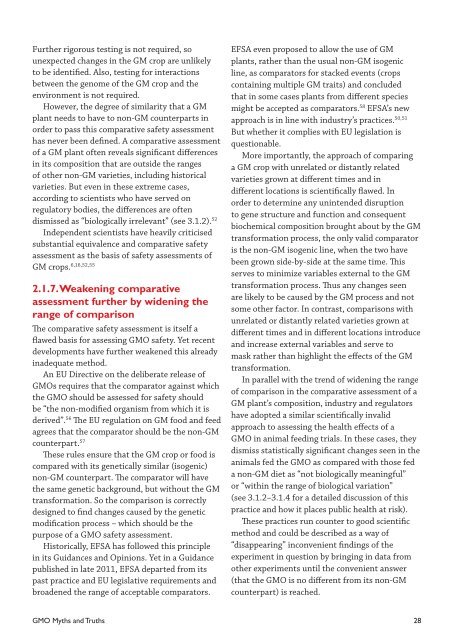GMO Myths and Truths
GMO Myths and Truths
GMO Myths and Truths
Create successful ePaper yourself
Turn your PDF publications into a flip-book with our unique Google optimized e-Paper software.
Further rigorous testing is not required, so<br />
unexpected changes in the GM crop are unlikely<br />
to be identified. Also, testing for interactions<br />
between the genome of the GM crop <strong>and</strong> the<br />
environment is not required.<br />
However, the degree of similarity that a GM<br />
plant needs to have to non-GM counterparts in<br />
order to pass this comparative safety assessment<br />
has never been defined. A comparative assessment<br />
of a GM plant often reveals significant differences<br />
in its composition that are outside the ranges<br />
of other non-GM varieties, including historical<br />
varieties. But even in these extreme cases,<br />
according to scientists who have served on<br />
regulatory bodies, the differences are often<br />
dismissed as “biologically irrelevant” (see 3.1.2). 52<br />
Independent scientists have heavily criticised<br />
substantial equivalence <strong>and</strong> comparative safety<br />
assessment as the basis of safety assessments of<br />
GM crops. 6,16,52,55<br />
2.1.7. Weakening comparative<br />
assessment further by widening the<br />
range of comparison<br />
The comparative safety assessment is itself a<br />
flawed basis for assessing <strong>GMO</strong> safety. Yet recent<br />
developments have further weakened this already<br />
inadequate method.<br />
An EU Directive on the deliberate release of<br />
<strong>GMO</strong>s requires that the comparator against which<br />
the <strong>GMO</strong> should be assessed for safety should<br />
be “the non-modified organism from which it is<br />
derived”. 56 The EU regulation on GM food <strong>and</strong> feed<br />
agrees that the comparator should be the non-GM<br />
counterpart. 57<br />
These rules ensure that the GM crop or food is<br />
compared with its genetically similar (isogenic)<br />
non-GM counterpart. The comparator will have<br />
the same genetic background, but without the GM<br />
transformation. So the comparison is correctly<br />
designed to find changes caused by the genetic<br />
modification process – which should be the<br />
purpose of a <strong>GMO</strong> safety assessment.<br />
Historically, EFSA has followed this principle<br />
in its Guidances <strong>and</strong> Opinions. Yet in a Guidance<br />
published in late 2011, EFSA departed from its<br />
past practice <strong>and</strong> EU legislative requirements <strong>and</strong><br />
broadened the range of acceptable comparators.<br />
EFSA even proposed to allow the use of GM<br />
plants, rather than the usual non-GM isogenic<br />
line, as comparators for stacked events (crops<br />
containing multiple GM traits) <strong>and</strong> concluded<br />
that in some cases plants from different species<br />
might be accepted as comparators. 58 EFSA’s new<br />
approach is in line with industry’s practices. 50,51<br />
But whether it complies with EU legislation is<br />
questionable.<br />
More importantly, the approach of comparing<br />
a GM crop with unrelated or distantly related<br />
varieties grown at different times <strong>and</strong> in<br />
different locations is scientifically flawed. In<br />
order to determine any unintended disruption<br />
to gene structure <strong>and</strong> function <strong>and</strong> consequent<br />
biochemical composition brought about by the GM<br />
transformation process, the only valid comparator<br />
is the non-GM isogenic line, when the two have<br />
been grown side-by-side at the same time. This<br />
serves to minimize variables external to the GM<br />
transformation process. Thus any changes seen<br />
are likely to be caused by the GM process <strong>and</strong> not<br />
some other factor. In contrast, comparisons with<br />
unrelated or distantly related varieties grown at<br />
different times <strong>and</strong> in different locations introduce<br />
<strong>and</strong> increase external variables <strong>and</strong> serve to<br />
mask rather than highlight the effects of the GM<br />
transformation.<br />
In parallel with the trend of widening the range<br />
of comparison in the comparative assessment of a<br />
GM plant’s composition, industry <strong>and</strong> regulators<br />
have adopted a similar scientifically invalid<br />
approach to assessing the health effects of a<br />
<strong>GMO</strong> in animal feeding trials. In these cases, they<br />
dismiss statistically significant changes seen in the<br />
animals fed the <strong>GMO</strong> as compared with those fed<br />
a non-GM diet as “not biologically meaningful”<br />
or “within the range of biological variation”<br />
(see 3.1.2–3.1.4 for a detailed discussion of this<br />
practice <strong>and</strong> how it places public health at risk).<br />
These practices run counter to good scientific<br />
method <strong>and</strong> could be described as a way of<br />
“disappearing” inconvenient findings of the<br />
experiment in question by bringing in data from<br />
other experiments until the convenient answer<br />
(that the <strong>GMO</strong> is no different from its non-GM<br />
counterpart) is reached.<br />
<strong>GMO</strong> <strong>Myths</strong> <strong>and</strong> <strong>Truths</strong> 28


